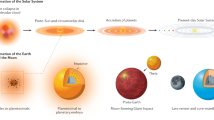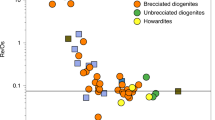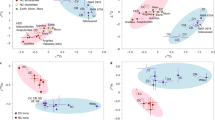Abstract
Earth grew through collisions with Moon-sized to Mars-sized planetary embryos from the inner Solar System, but it also accreted material from greater heliocentric distances1,2, including carbonaceous chondrite-like bodies, the likely source of Earth’s water and highly volatile species3,4. Understanding when and how this material was added to Earth is critical for constraining the dynamics of terrestrial planet formation and the fundamental processes by which Earth became habitable. However, earlier studies inferred very different timescales for the delivery of carbonaceous chondrite-like bodies, depending on assumptions about the nature of Earth’s building materials5,6,7,8,9,10,11. Here we show that the Mo isotopic composition of Earth’s primitive mantle falls between those of the non-carbonaceous and carbonaceous reservoirs12,13,14,15, and that this observation allows us to quantify the accretion of carbonaceous chondrite-like material to Earth independently of assumptions about its building blocks. As most of the Mo in the primitive mantle was delivered by late-stage impactors10, our data demonstrate that Earth accreted carbonaceous bodies late in its growth history, probably through the Moon-forming impact. This late delivery of carbonaceous material probably resulted from an orbital instability of the gas giant planets, and it demonstrates that Earth’s habitability is strongly tied to the very late stages of its growth.
This is a preview of subscription content, access via your institution
Access options
Access Nature and 54 other Nature Portfolio journals
Get Nature+, our best-value online-access subscription
$29.99 / 30 days
cancel any time
Subscribe to this journal
Receive 12 digital issues and online access to articles
$119.00 per year
only $9.92 per issue
Buy this article
- Purchase on Springer Link
- Instant access to full article PDF
Prices may be subject to local taxes which are calculated during checkout




Similar content being viewed by others
Data availability
All data generated during this study are included in this article (and its Supplementary Information files).
References
Morbidelli, A., Lunine, J. I., O’Brien, D. P., Raymond, S. N. & Walsh, K. J. Building terrestrial planets. Annu. Rev. Earth Planet. Sci. 40, 251–275 (2012).
O’Brien, D. P., Izidoro, A., Jacobson, S. A., Raymond, S. N. & Rubie, D. C. The delivery of water during terrestrial planet formation. Space Sci. Rev. 214, 47 (2018).
Alexander, C. M. O’D. et al. The provenances of asteroids, and their contributions to the volatile inventories of the terrestrial planets. Science 337, 721–723 (2012).
Marty, B. The origins and concentrations of water, carbon, nitrogen and noble gases on Earth. Earth Planet. Sci. Lett. 313-314, 56–66 (2012).
Rubie, D. C. et al. Accretion and differentiation of the terrestrial planets with implications for the compositions of early-formed Solar System bodies and accretion of water. Icarus 248, 89–108 (2015).
Wang, Z. & Becker, H. Ratios of S, Se and Te in the silicate Earth require a volatile-rich late veneer. Nature 499, 328–331 (2013).
Albarede, F. Volatile accretion history of the terrestrial planets and dynamic implications. Nature 461, 1227–1233 (2009).
Fischer-Gödde, M. & Kleine, T. Ruthenium isotopic evidence for an inner Solar System origin of the late veneer. Nature 541, 525–527 (2017).
Schiller, M., Bizzarro, M. & Fernandes, V. A. Isotopic evolution of the protoplanetary disk and the building blocks of Earth and the Moon. Nature. 555, 507–510 (2018).
Dauphas, N. The isotopic nature of the Earth’s accreting material through time. Nature 541, 521–524 (2017).
Bermingham, K. R., Worsham, E. A. & Walker, R. J. New insights into Mo and Ru isotope variation in the nebula and terrestrial planet accretionary genetics. Earth Planet. Sci. Lett. 487, 221–229 (2018).
Budde, G. et al. Molybdenum isotopic evidence for the origin of chondrules and a distinct genetic heritage of carbonaceous and non-carbonaceous meteorites. Earth Planet. Sci. Lett. 454, 293–303 (2016).
Kruijer, T. S., Burkhardt, C., Budde, G. & Kleine, T. Age of Jupiter inferred from the distinct genetics and formation times of meteorites. Proc. Natl Acad. Sci. USA 114, 6712–6716 (2017).
Poole, G. M., Rehkämper, M., Coles, B. J., Goldberg, T. & Smith, C. L. Nucleosynthetic molybdenum isotope anomalies in iron meteorites—new evidence for thermal processing of solar nebula material. Earth Planet. Sci. Lett. 473, 215–226 (2017).
Worsham, E. A., Bermingham, K. R. & Walker, R. J. Characterizing cosmochemical materials with genetic affinities to the Earth: genetic and chronological diversity within the IAB iron meteorite complex. Earth Planet. Sci. Lett. 467, 157–166 (2017).
Burkhardt, C. et al. A nucleosynthetic origin for the Earth’s anomalous 142Nd composition. Nature 537, 394–398 (2016).
Render, J., Fischer-Gödde, M., Burkhardt, C. & Kleine, T. The cosmic molybdenum-neodymium isotope correlation and the building material of the Earth. Geochem. Persp. Lett. 3, 170–178 (2017).
Warren, P. H. Stable-isotopic anomalies and the accretionary assemblage of the Earth and Mars: a subordinate role for carbonaceous chondrites. Earth Planet. Sci. Lett. 311, 93–100 (2011).
Nicolussi, G. K. et al. Molybdenum isotopic composition of individual presolar silicon carbide grains from the Murchison meteorite. Geochim. Cosmochim. Acta 62, 1093–1104 (1998).
Nanne, J. A. M., Nimmo, F., Cuzzi, J. N. & Kleine, T. Origin of the non-carbonaceous–carbonaceous meteorite dichotomy. Earth Planet. Sci. Lett. 511, 44–54 (2019).
Steele, R. C. J., Elliott, T., Coath, C. D. & Regelous, M. Confirmation of mass-independent Ni isotopic variability in iron meteorites. Geochim. Cosmochim. Acta 75, 7906–7925 (2011).
Zhang, J. J., Dauphas, N., Davis, A. M., Leya, I. & Fedkin, A. The proto-Earth as a significant source of lunar material. Nat. Geosci. 5, 251–255 (2012).
Canup, R. M. & Asphaug, E. Origin of the Moon in a giant impact near the end of the Earth’s formation. Nature 412, 708–712 (2001).
Walker, R. J. Highly siderophile elements in the Earth, Moon and Mars: update and implications for planetary accretion and differentiation. Chem. Erde-Geochem. 69, 101–125 (2009).
Rudge, J. F., Kleine, T. & Bourdon, B. Broad bounds on Earth’s accretion and core formation constrained by geochemical models. Nat. Geosci. 3, 439–443 (2010).
Fehr, M. A., Hammond, S. J. & Parkinson, I. J. Tellurium stable isotope fractionation in chondritic meteorites and some terrestrial samples. Geochim. Cosmochim. Acta 222, 17–33 (2018).
Bermingham, K. R. & Walker, R. J. The ruthenium isotopic composition of the oceanic mantle. Earth Planet. Sci. Lett. 474, 466–473 (2017).
Meisel, T., Walker, R. J. & Morgan, J. W. The osmium isotopic composition of the Earth’s primitive upper mantle. Nature 383, 517–520 (1996).
Akram, W. & Schönbächler, M. Zirconium isotope constraints on the composition of Theia and current Moon-forming theories. Earth Planet. Sci. Lett. 449, 302–310 (2016).
Canup, R. M. Forming a Moon with an Earth-like composition via a giant impact. Science 338, 1052–1055 (2012).
Cuk, M. & Stewart, S. T. Making the Moon from a fast-spinning Earth: a giant impact followed by resonant despinning. Science 338, 1047–1052 (2012).
Lock, S. J. et al. The origin of the Moon within a terrestrial synestia. J. Geophys. Res. 123, 910–951 (2018).
O’Brien, D. P., Walsh, K. J., Morbidelli, A., Raymond, S. N. & Mandell, A. M. Water delivery and giant impacts in the ‘Grand Tack’ scenario. Icarus 239, 74–84 (2014).
O’Brien, D. P., Morbidelli, A. & Levison, H. F. Terrestrial planet formation with strong dynamical friction. Icarus 184, 39–58 (2006).
Reisberg, L. et al. Nucleosynthetic osmium isotope anomalies in acid leachates of the Murchison meteorite. Earth Planet. Sci. Lett. 277, 334–344 (2009).
Budde, G., Kruijer, T. S. & Kleine, T. Hf-W chronology of CR chondrites: implications for the timescales of chondrule formation and the distribution of 26Al in the solar nebula. Geochim. Cosmochim. Acta 222, 284–304 (2018).
Burkhardt, C. et al. Molybdenum isotope anomalies in meteorites: constraints on solar nebula evolution and origin of the Earth. Earth Planet. Sci. Lett. 312, 390–400 (2011).
Acknowledgements
We are grateful to NASA and the Institute of Meteoritics, University of New Mexico, for providing samples. We are also grateful to K. Metzler, G. Brennecka and A. Bischoff for discussions, C. Brennecka for comments on the paper, U. Heitmann for technical support, as well as R. Walker and K. Bermingham (University of Maryland) for providing their Mo solution standard. This study was supported by the European Research Council Consolidator Grant “ISOCORE” (contract 616564) and by the Deutsche Forschungsgemeinschaft (SFB/TRR 170 subproject B3-1). This is TRR publication no. 61.
Author information
Authors and Affiliations
Contributions
G.B., C.B. and T.K. devised the study. G.B. prepared the samples for Mo isotope analyses and performed all measurements. All authors contributed to the interpretation of the data and preparation of the manuscript.
Corresponding author
Ethics declarations
Competing interests
The authors declare no competing interests.
Additional information
Publisher’s note: Springer Nature remains neutral with regard to jurisdictional claims in published maps and institutional affiliations.
Supplementary information
Supplementary Information
Supplementary Text, Supplementary Figures 1–6, Supplementary Tables 1–4, Supplementary References and Supplementary Data 1 caption.
Supplementary Data 1
Data file for Supplementary Table 4. Summary of Mo isotope data and references for bulk meteorites as displayed in Fig. 1 and used for calculations of CC and NC lines.
Rights and permissions
About this article
Cite this article
Budde, G., Burkhardt, C. & Kleine, T. Molybdenum isotopic evidence for the late accretion of outer Solar System material to Earth. Nat Astron 3, 736–741 (2019). https://doi.org/10.1038/s41550-019-0779-y
Received:
Accepted:
Published:
Issue Date:
DOI: https://doi.org/10.1038/s41550-019-0779-y
This article is cited by
-
Degassing of early-formed planetesimals restricted water delivery to Earth
Nature (2023)
-
Phosphorus availability on the early Earth and the impacts of life
Nature Geoscience (2023)
-
Nitrogen isotope evidence for Earth’s heterogeneous accretion of volatiles
Nature Communications (2022)
-
Origin of life-forming volatile elements in the inner Solar System
Nature (2022)
-
The accretion of planet Earth
Nature Reviews Earth & Environment (2022)



